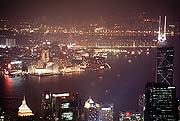|
D. Nontariff Trade Barriers
1. Absolute quotas
- Physical restriction on the quantity of goods
that may be imported into a country
- Quotas on manufactured goods outlawed by WTO
- Used primarily by developed countries against
agricultural producers
a. Implementation
(1) Import licenses required
- Could be based on historic share of imports
- discriminates against new companies
- Pro-rata share of domestic market,
auctioning also used
.
(2) Global quota - specified amount of
goods can be imported
- No specification of where goods can come
from
- Leads to a rush by exporting countries to
get products in before quota is filled
- Could lead to monopoly, favoritism
.
(3) Selective quota - quotas allocated to
specific countries
- Could have same problems as global quotas
.
b. Welfare effects
.
.
.
.
.
.
.
.
.
.
- Quota less desirable than tariff,
particularly when demand is growing
- Both increase price, but tariff doesn't
restrict quantity
- Tariffs allow for some degree of competition
.
.
.
.
.
.
.
.
.
.
- WTO has sought to replace quotas with tariffs
- "tariffication"
.
2. Tariff-rate quotas (two-tier tariff)
- A specified amount of imports can be imported at
one tariff rate
- Imports above specified amount are allowed, but
pay a much higher rate
.
.
.
- Must decide import-quota threshold, within-quota
tariff, and over-quota tariff
a. Welfare effects
.
.
.
.
.
.
.
.
.
.
b. Implementation
- License on demand allocation
.
3. Export quotas
- Voluntary export restraint agreement - orderly
marketing agreement
- More efficient countries voluntarily restrain
level of exports
Ex. - 1980s - Steel, automobiles, textiles
.
4. Domestic content requirements
- Minimum percentage of a product's total value
must be produced domestically
- Increases demand for domestic inputs => higher
input prices
.
.
.
.
.
.
.
.
.
.
5. Subsidies
a. Domestic subsidy
- Given to import-competing manufacturers
- Cash distributions, tax breaks,
insurance arrangements, loans at below market interest
- Reduces cost of production
.
.
.
.
.
.
.
.
.
.
b. Export subsidy
- Encourage exports by reducing price foreign
consumers pay
- Terms-of-trade effect - terms of trade
worsens as foreign price of exports drops
- Export-revenue effect - export revenue
affected by lower prices but higher export volume
.
.
.
.
.
.
.
.
.
.
6. Dumping
- Foreign buyers charged lower price than domestic
buyers
- Also selling in foreign markets for a price below
the cost of production
a. Forms of dumping
(1) Sporadic dumping (distress dumping)
- firm disposes of excess inventory on foreign markets at lower
prices than at home
(2) Predatory dumping - producer
temporarily reduces prices to drive foreign competitors out of
business
(3) Persistent dumping - dumping goes
on indefinitely
.
b. International price discrimination
- Charge different prices in different
countries for the same product
- Charge higher price when demand is inelastic
(market power), lower price when demand is inelastic (competition)
.
.
.
.
.
.
.
.
.
.
c. Antidumping regulations
- Antidumping duty levied when imports sold at
less than fair value (LTFV) and such sales cause material injury to
a U.S. industry
- Should average variable cost be used?
- Doesn't take into account currency
fluctuations
- Overused to provide protection
.
7. Other barriers
a. Government procurement policies
- Government gives preference to domestic
suppliers in purchases - "buy-national" policies
- Higher costs, welfare losses
.
b. Social regulations
- Correct undesirable side effects in an
economy
- Health, safety, environment
Ex. - CAFE standards, hormones in beef
.
c. Sea transport and freight restrictions
- Restrictions as to what can be done in
transporting goods
|


